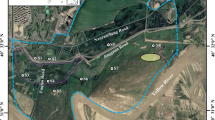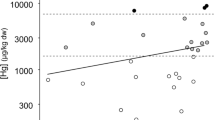Abstract
Owls are outstanding environmental quality bioindicators due to their position at the top of the food chain and susceptibility to pollutant accumulation. Exposure to chemical contaminants is often a risk for these animals. Moreover, studies addressing the bioaccumulation of trace elements and pesticide residues in tropical nocturnal raptor species are scarce. We analyzed the 26 organs (heart, liver, and kidney) of Tyto furcata (n=3), Megascops spp. (n=5), Pulsatrix koeniswaldiana (n=1), and Asio stygius (n=1) carcasses, collected from June 2018 to May 2019 in the Southern region of Brazil. The original vegetation consisted of areas of Araucaria forests and grassy-woody steppes with gallery forests, which were greatly modified by the introduction of agriculture. In four animals and eight organs, the pesticides abamectin, atrazine, chlorpyrifos-ethyl, and diurom were analyzed through high-performance liquid chromatography coupled with a mass detector. In six animals and eighteen organs, the trace elements cadmium, lead, chromium, and nickel were identified via atomic absorption spectrophotometry. Chlorpyrifos-ethyl was detected in the livers of the genus Megascops. Chromium was found at high concentrations in all matrices analyzed for this trace element. Moreover, P. koeniswaldiana presented lead levels indicative of high exposure. The bioaccumulation of these toxics in owls described here can impact the population levels of these species, impact on its ecological function, and consequently unbalance the ecosystem. Moreover, owls are considered bioindicators; therefore, the occurrence of bioaccumulation indirectly gives us information about the quality of the environment.

Similar content being viewed by others
Data Availability
The datasets used and/or analyzed during the current study are available from the corresponding author on reasonable request.
References
Agência Nacional de Vigilância Sanitária (Anvisa) (2016) Programa de Agência análises de resíduos de agrotóxicos emalimentos (PARA): Relatório das análises de amostras monitoradas no período de 2013 a 2015. Anvisa, Brasília
Alharbi HA, Letcher RJ, Mineau P et al (2016) Organophosphate pesticide method development and presence of chlorpyrifos in the feet of nearctic-neotropical migratory songbirds from Canada that over-winter in Central America agricultural areas. Chemosphere 144:827–835. https://doi.org/10.1016/j.chemosphere.2015.09.052
Alvares CA, Stape JL, Sentelhas PC et al (2013) Köppen’s climate classification map for Brazil. Meteorol Z 22:711–728. https://doi.org/10.1127/0941-2948/2013/0507
Arrona-Rivera AE, Enríquez PL, García-Feria LM et al (2016) Organochlorine pesticides in the ferruginous pygmy owl (Glaucidium brasilianum) in Chiapas, Mexico. Bull Environ Contam Toxicol 97:337–345. https://doi.org/10.1007/s00128-016-1861-0
Battaglia A, Ghidini S, Campanini G, Spaggiari R (2005) Heavy metal contamination in little owl (Athene noctua) and common buzzard (Buteo buteo) from northern Italy. Ecotoxicol Environ Saf 60:61–66. https://doi.org/10.1016/j.ecoenv.2003.12.019
Bencke GA, Bencke CSC (1999) The potential importance of road deaths as a cause of mortality for large forest owls in southern Brazil. Cotinga 11:17–18
Beyer WN, Spann JW, Sileo L, Franson JC (1988) Lead poisoning in six captive avian species. Arch Environ Contain Toxicol 17:121–130
Burger J, Gochfeld M (2005) Effects of lead on learning in herring gulls: an avian wildlife model for neurobehavioral deficits. Neurotoxicology 26:615–624. https://doi.org/10.1016/j.neuro.2005.01.005
Chambers JE, Carr RL (1995) Biochemical mechanisms contributing to species differences in insecticidal toxicity. Toxicology 105:291–304. https://doi.org/10.1016/0300-483X(95)03225-5
Chanda SM, Mortensen SR, Moser VC, Padilla S (1997) Tissue-specific effects of chlorpyrifos on carboxylesterase and cholinesterase activity in adult rats: an in vitro and in vivo comparison. Fundam Appl Toxicol 7:148–157
Dal Pizzol GE, Rezende E, Kilpp JC et al (2020) Biomonitoring of owls and their environment using pellets and feathers. Bull Environ Contam Toxicol 105:685–691. https://doi.org/10.1007/s00128-020-03024-3
Dauwe T, Bervoets L, Pinxten R et al (2003) Variation of heavy metals within and among feathers of birds of prey: effects of molt and external contamination. Environ Pollut 124:429–436. https://doi.org/10.1016/S0269-7491(03)00044-7
Debén S, Ángel Fernández J, Aboal JR, Carballeira A (2012) Evaluation of different contour feather types for biomonitoring lead exposure in Northern goshawk (Accipiter gentilis) and tawny owl (Strix aluco). Ecotoxicol Environ Saf 85:115–119. https://doi.org/10.1016/j.ecoenv.2012.08.005
Deng Y, Zhang Y, Lu Y et al (2016) Hepatotoxicity and nephrotoxicity induced by the chlorpyrifos and chlorpyrifos-methyl metabolite, 3,5,6-trichloro-2-pyridinol, in orally exposed mice. Sci Total Environ 544:507–514. https://doi.org/10.1016/j.scitotenv.2015.11.162
Eisler R (1988) Lead hazards to fish, wildlife and inverterbrates: a synoptic review. Biol Reprod 85:1–146. https://doi.org/10.5962/bhl.title.11357
Elsharkawy EE, Yahia D, El-Nisr NA (2012) Sub-chronic exposure to chlorpyrifos induces hematological , metabolic disorders and oxidative stress in rat: attenuation by glutathione. Environ Toxicol Pharmacol 35:218–227. https://doi.org/10.1016/j.etap.2012.12.009
Espín S, Martínez-López E, León-Ortega M et al (2014a) Oxidative stress biomarkers in Eurasian eagle owls (Bubo bubo) in three different scenarios of heavy metal exposures. Environ Res 131:134–144. https://doi.org/10.1016/j.envres.2014.03.015
Espín S, Martínez-López E, León-Ortega M et al (2014b) Factors that influence mercury concentrations in nestling Eagle Owls (Bubo bubo). Sci Total Environ 470–471:1132–1139. https://doi.org/10.1016/j.scitotenv.2013.10.063
Esselink H, van der Geld FM, Jager LP et al (1995) Biomonitoring heavy metals using the barn owl (Tyto alba guttata): sources of variation especially relating to body condition. Arch Environ Contam Toxicol 28:471–486
Fundação Estadual de Proteção Ambiental Henrique Luís Roessler (FEPAM) (2014) Portaria Fepam N.o 85/2014. FEPAM, Porto Alegre
Franson JC, Pain DJ (2011) Lead in birds. In: Environmental Contaminants in biota: interpreting tissue concentrations. Ed. CRC Press, Boca Raton, Florida, United States, p 768
Gad SC (1989) Acute and chronic systemic chromium toxicity. Sci Total Environ 86:149–157. https://doi.org/10.1016/0048-9697(89)90201-5
Gervais JA, Rosenberg DK, Fry DM et al (2000) Burrowing owls and agricultural pesticides: evaluation of residues and risks for three populations in California, USA. Environ Toxicol Chem 19:337–343. https://doi.org/10.1002/etc.5620190213
Grilo C, Coimbra MR, Cerqueira RC et al (2018) Brazil road-kill: a data set of wildlife terrestrial vertebrate road-kills. Ecology 99:2625. https://doi.org/10.1002/ecy.2464
Guadagnin DL, Perello LFC, Menegheti JO (2007) Current situation of leisure hunting and wetland management in Rio Grande. 2:63–70
Guasselli LA, Saldanha DL, Suertegaray DMA et al (2006) Macrozoneamento do Estado do Rio Grande do Sul. Pesqui em Geociências 33:3–11
Husby M (2017) Traffic influence on roadside bird abundance and behaviour. Acta Ornithol 52:93–103. https://doi.org/10.3161/00016454AO2017.52.1.009
Instituto Brasileiro do Meio Ambiente e dos Recursos Naturais Renováveis (IBAMA) (2017a) Vendas por estados e regiões brasileiras. In: Vendas UF 2017. http://ibama.gov.br/agrotoxicos/relatorios-de-comercializacao-de-agrotoxicos#boletinsanuais. Accessed 20 Nov 2019
Instituto Brasileiro do Meio Ambiente e dos Recursos Naturais Renováveis (IBAMA) (2017b) Agrotóxicos - Os 10 ingredientes ativos mais vendidos. http://ibama.gov.br/agrotoxicos/relatorios-de-comercializacao-de-agrotoxicos#boletinsanuais. Accessed 25 Jun 2019
Instituto Brasileiro do Meio Ambiente e dos Recursos Naturais Renováveis (IBAMA) (2017c) Agrotóxicos - Produção, importação, exportação e vendas. http://ibama.gov.br/agrotoxicos/relatorios-de-comercializacao-de-agrotoxicos#boletinsanuais. Accessed 25 Jun 2019
Instituto Brasileiro de Geografia e Estatística (IBGE) (1991) Manual Técnico da Vegetação Brasileira. IBGE, Rio de Janeiro
Jaspers V, Covaci A, Maervoet J et al (2005) Brominated flame retardants and organochlorine pollutants in eggs of little owls (Athene noctua) from Belgium. Environ Pollut 136:81–88. https://doi.org/10.1016/j.envpol.2004.12.003
Kendall RJ, Lacher Jr, Thomas E, Bunck C, Daniel B et al (1996) An ecological risk assessment of lead shot exposure in non-waterfowl avian species: upland game birds and raptors. Environ Toxicol Chem 15:4–20
Kirk DA, Hyslop C (1998) Population status and recent trends in Canadian raptors: a review. Biol Conserv 83:91–118. https://doi.org/10.1016/S0006-3207(97)00051-7
Kopjar N, Suzana Ž, Mendas G et al (2018) Evaluation of chlorpyrifos toxicity through a 28-day study: cholinesterase activity, oxidative stress responses, parent compound/metabolite levels, and primary DNA damage in blood and brain tissue of adult male Wistar rats. Chem Biol Interact 279:51–63. https://doi.org/10.1016/j.cbi.2017.10.029
López-Crespo GA, Carvajal F, Flores P et al (2007) Time course of biochemical and behavioural effects of a single high dose of chlorpyrifos. Neurotoxicology 28:541–547. https://doi.org/10.1016/j.neuro.2007.01.013
López-Granero C, Cañadas F, Cardona D et al (2013) Chlorpyrifos-, diisopropylphosphorofluoridate-, and parathion-induced behavioral and oxidative stress effects: are they mediated by analogous mechanisms of action? Toxicol Sci 131:206–216. https://doi.org/10.1093/toxsci/kfs280
Majó N, Dolz R (2018) Atlas de la necropsia aviar: Diagnóstico macroscópico, toma de muestras. Ed. SERVET, Zaragoza, Spain, p 100
Malik RN, Zeb N (2009) Assessment of environmental contamination using feathers of Bubulcus ibis L., as a biomonitor of heavy metal pollution, Pakistan. Ecotoxicology 18:522–536
Martin PA, Hughes KD, Campbell GD, Shutt JL (2017) Metals and organohalogen contaminants in bald eagles (Haliaeetus leucocephalus) from Ontario, 1991–2008. Arch Environ Contam Toxicol 74:305–317
Martínez JA, Martínez JE, Mañosa S et al (2006) How to manage human-induced mortality in the Eagle Owl Bubo bubo. Bird Conserv Int 16:265–278. https://doi.org/10.1017/S0959270906000402
Mineau P, Fletcher MR, Glaser LC et al (1999) Poisoning of raptors with organophosphorus and carbamate pesticides with emphasis on Canada, U.S. and U.K. J Raptor Res 33:1–37
Moore KC (1977) Investigations of waterfowl lead poisoning in California. Cal-Neva Wildl Trans:19–26
Nava IA, Gonçalves Junior AC, Nacke H et al (2011) Availability of cadmium, lead and chromium toxic heavy metals in soil and soybean leaf tissue fertilized with different sources of NPK+Zn. Ciênc Agrotecnol 35:884–892
Pain DJ, Sears J, Newton I (1995) Lead concentrations in birds of prey in Britain. Environ Pollut 87:173–180. https://doi.org/10.1016/0269-7491(94)P2604-8
Park M-J, In S-W, Lee S et al (2009) Postmortem blood concentrations of organophosphorus pesticides. Forensic Sci Int 184:28–31. https://doi.org/10.1016/j.forsciint.2008.11.008
Pérez-López M, Mendoza MH d, Beceiro AL, Rodríguez FS (2008) Heavy metal (Cd, Pb, Zn) and metalloid (As) content in raptor species from Galicia (NW Spain). Ecotoxicol Environ Saf 70:154–162. https://doi.org/10.1016/j.ecoenv.2007.04.016
Scheuhammer AM (1987) The chronic toxicity of aluminium, cadmium, mercury, and lead in birds: A review. Environ Pollut 46:263–295. https://doi.org/10.1016/0269-7491(87)90173-4
Shahbaz M, Hashmi MZ, Malik RN, Yasmin A (2013) Relationship between heavy metals concentrations in egret species, their environment and food chain differences from two Headworks of Pakistan. Chemosphere 93:274–282. https://doi.org/10.1016/j.chemosphere.2013.04.078
Shin D-M, Oh J-M, Kim J (2018) Metal concentrations in Eurasian eagle owl pellets as a function of reproductive variables in Korea. Arch Environ Contam Toxicol 74:298–304
Strause KD, Zwiernik MJ, Im SH et al (2007) Plasma to egg conversion factor for evaluating polychlorinated biphenyl and DDT exposures in great horned owls and bald eagles. Environ Toxicol Chem 26:1399–1409. https://doi.org/10.1897/06-383R.1
Taliansky-Chamudis A, Gómez-Ramírez P, León-Ortega M, García-Fernández AJ (2017) Validation of a QuEChERS method for analysis of neonicotinoids in small volumes of blood and assessment of exposure in Eurasian eagle owl (Bubo bubo) nestlings. Sci Total Environ 595:93–100. https://doi.org/10.1016/j.scitotenv.2017.03.246
Topographic-map (2020) Mapas Topográficos Rio Grande do Sul. https://pt-br.topographic-map.com/places/ti/Rio-Grande-do-Sul/. Accessed 14 Dec 2020
United States Environmental Protection Agency (US EPA) (1996) Method 3050B (Acid digestions of sediments, sludges and soils). US EPA, Washington.
Verma RS, Bhatt A, Srivastava N (2007) In vivo chlorpyrifos induced oxidative stress: attenuation by antioxidant vitamins. Pestic Biochem Physiol 88:191–196. https://doi.org/10.1016/j.pestbp.2006.11.002
Zaccaroni A, Lucisano A, Stracciari GL (2003) Cadmium, chromium and lead contamination of Athene noctua, the little owl, of Bologna and Parma. Italy. 52:1251–1258. https://doi.org/10.1016/S0045-6535(03)00363-1
Acknowledgements
Thanks to FAPERGS (Fundação de Amparo à Pesquisa do estado do Rio Grande do Sul), the Programa de Pós-Graduação em Bioexperimentação (FAMV), and the Universidade de Passo Fundo for making this research feasible. To the employees of the Laboratório de Solos, Museu Zoobotânico Augusto Ruschi. Thanks to Laboratório de Análises Clínicas Escola (LABE-UPF). To reviewers for suggestions on the manuscript. Gabriela Elisa Dal Pizzol: Scholarship CAPES/BRASIL.
Funding
This study had the support of FAPERGS, by means of the edicts 05/2017 (Project n° 88887.161013/2017-00) and ARD/2017 (grant term number 17/2551-0000 804-9).
Author information
Authors and Affiliations
Contributions
GEP collected, analyzed, interpreted data about owl’s contamination, and wrote the manuscript. VAR extracted and analyzed pesticide residues in organs. ER and JCK collected owls. MMF analyzed trace elements in organs. EM, ANS, and LBR performed necropsies in owls. CDB and MTF performed LC/MS-MS analysis of pesticide residues. LGRG designed, analyzed, interpreted data, and corrected the manuscript.
Corresponding author
Ethics declarations
Ethics approval
This study had ethical approval from SISBIO (Sistema de Autorização e Informação em Biodiversidade—n° 60.000) and CEUA-UPF (Comissão de Ética no Uso de Animais—n° 003/2018).
Consent for publication/participation
Not applicable.
Conflict of interest
The authors declare no competing interests.
Additional information
Responsible editor: Philippe Garrigues
Publisher’s note
Springer Nature remains neutral with regard to jurisdictional claims in published maps and institutional affiliations.
Rights and permissions
About this article
Cite this article
Dal Pizzol, G.E., Rosano, V.A., Rezende, E. et al. Pesticide and trace element bioaccumulation in wild owls in Brazil. Environ Sci Pollut Res 28, 37843–37850 (2021). https://doi.org/10.1007/s11356-021-13210-3
Received:
Accepted:
Published:
Issue Date:
DOI: https://doi.org/10.1007/s11356-021-13210-3




